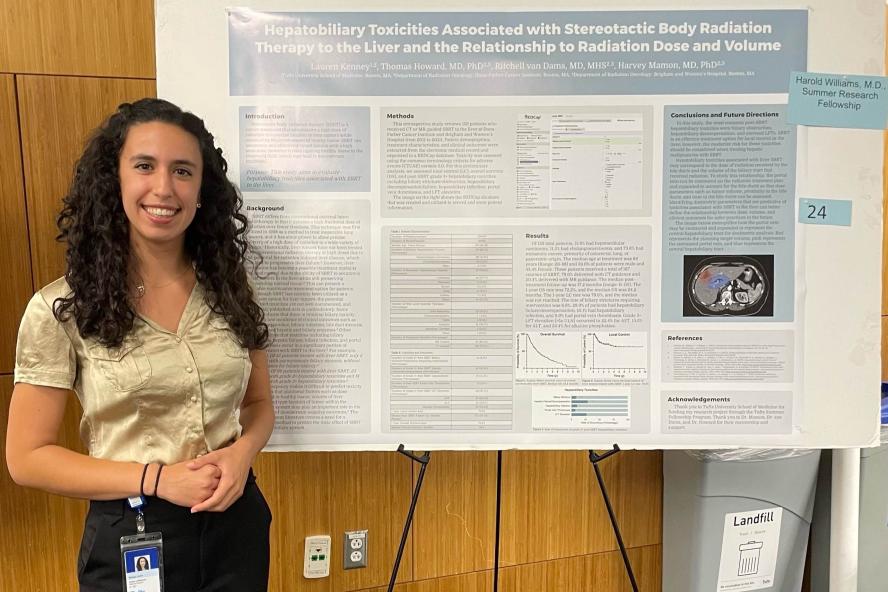-
About
- Departments & Offices
-
Academics
- Physician Assistant
- Special Master’s (MBS)
-
Admissions & Financial Aid
- Tuition & Fees
-
Student Experience
-
- Student Resources by Program
- Academic & Student Support
- Wellness & Wellbeing
- Student Life
- Events & Traditions
-
-
Research
- Research Labs & Centers
-
Local & Global Engagement
- Global Health Programs
- Community Engagement
Summer Research Fuels MD Student’s Passion for Progress
Lauren Kenney, a Tufts MD student, connects personal experiences with advances in radiation oncology research.

By Lauren Kenney, M27
Cancer is a disease that affects everyone in some way, touching lives both broadly and personally. At a population level, cancer incidence rates are steadily rising. On a more intimate scale, cancer infiltrates families, ambushes unsuspecting patients, and weaponizes one's own cells against them. To combat this, oncology research is continually evolving to deepen our understanding of the disease, improve standard care practices, and develop treatment options that align with patient priorities. Research can provide real hope for reducing the devastating effects this disease has in our society and improving patients’ quality of life.
I was first introduced to oncology when my mother was diagnosed with cholangiocarcinoma, bile duct cancer, five years ago. Faced with a rare diagnosis and a challenging prognosis, she navigated various treatment options, including surgery, chemotherapy, immunotherapy, and radiation. The doctors who provided the most support and clarity offered thoughtful guidance grounded in the latest scientific research. As a medical student, I aspire to contribute to advancements in the field of oncology and to treat cancer patients with the same commitment to evidence-based care that has made such a difference in my mother’s journey.
This summer, between my first and second years of medical school, I took a step closer to that goal. Through the Tufts Summer Research Fellowship, I had the amazing opportunity to explore the field of radiation oncology with a team at Dana-Farber Cancer Institute. My research project was a retrospective study investigating the downstream toxicities associated with stereotactic body radiation therapy (SBRT) to the liver. SBRT is a treatment option that delivers a high dose of radiation to a specific location to provide precise tumor control while sparing surrounding healthy tissue. This can be especially useful in the liver, where there are a lot of essential structures, including bile ducts and vasculature.
While SBRT to the liver is a common practice in radiation oncology, the potential treatment-related adverse effects are not well documented, and existing studies present conflicting data. Could some treatments for some patients cause more harm than good? It was exciting to work on a project aimed at addressing this gap in the literature and potentially improving patient care.
Our primary research questions were: How effective is SBRT in preventing both local and regional tumor progression within the liver? What patient demographics and tumor characteristics are linked with the greatest success rates of SBRT? What clinical toxicities might patients experience following SBRT to the liver? And, specifically, is SBRT associated with toxicities such as biliary obstruction, hepatic failure, hepatobiliary infection, portal vein thrombosis, or elevated liver function tests?
Over the summer, my research involved reviewing patient charts to identify key study elements and create a comprehensive clinical database. Our dataset included 185 patients who received SBRT to the liver at Dana-Farber Cancer Institute or Brigham and Women’s Hospital between 2011 and 2024. These patients had either primary liver cancers, such as cholangiocarcinoma and hepatocellular carcinoma, or metastatic disease, cancer that had spread from its original location.
As I scoured oncology notes and radiology reports, I was fascinated by the scientific complexity of each case and the new medical terminology I encountered. At the same time, I was deeply moved by the fact that I was not just examining electronic patient records, but the lives of real people. Devastating medical conditions were distilled into objective data, such as lab values and PET scans, highlighting the stark contrast between clinical information and the associated personal struggles. With these patient hardships in mind, delving into the charts of individuals whose lives were upended by unexpected diagnoses, rocky treatment courses, and sometimes poor outcomes was difficult at times. However, it was centering to remind myself of the greater goal at hand and the potential to help patients facing similar challenges. I believe this in-depth insight will enable me to become a more knowledgeable and empathetic doctor.
My summer of research was an extremely fulfilling and enriching experience that deepened my understanding of radiation oncology and emphasized the crucial role of scientific literature in shaping patient care. Thanks to my supportive research mentors, I also had the opportunity to shadow in the clinic and experience the patient-facing side of radiation oncology. I also enjoyed learning the basics of contouring for developing radiation treatment plans. I hope to build on all the skills and perspectives that I gained from this summer research experience to become an evidence-informed physician.
Lauren Kenney is a second year MD student (Class of 2027) at Tufts University School of Medicine. She is co-president of the Oncology Interest Club and patient navigation director for the Sharewood Project. She also volunteers weekly with FriendshipWorks.